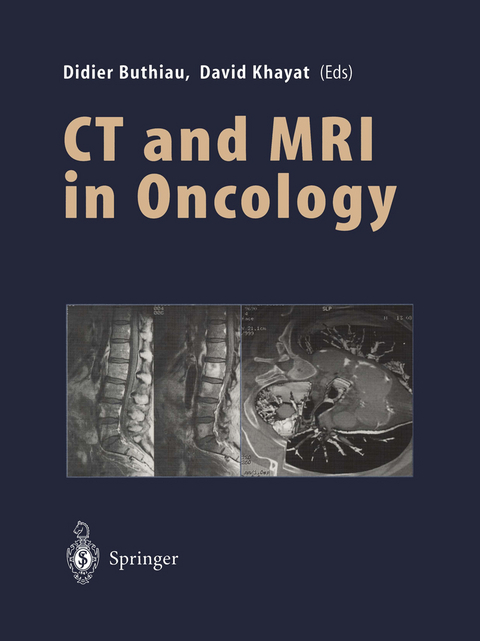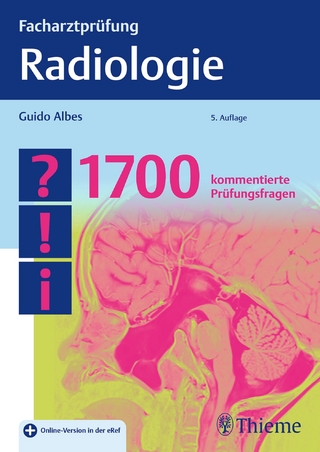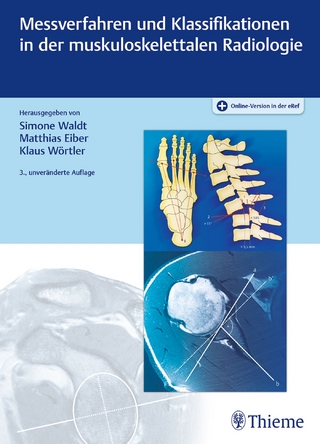
CT and MRI in Oncology
Springer Berlin (Verlag)
978-3-642-46844-5 (ISBN)
Introduction: Cancer, internal medicine and new imaging.- 1 Principles and performance of CT and MRI.- CT: performance and techniques.- Performance of a CT examination.- Patient explanation and details.- Contraindications.- Patient preparation.- Performance of the examination.- Viewing of the images.- Acquisition techniques and parameters.- Scanogram or scout view.- Thickness and spacing of the slices.- Interstice delays.- Field of view.- Matrix.- Filters.- Continuous rotation and helical mode.- Image reconstructions.- MRI: performance and techniques.- Performance of MRI.- Types of magnet.- Resistive.- Superconducting.- Permanent.- Field strength.- Coils.- Types of sequence.- Spin echo.- Inversion recovery.- Gradient echo.- Opposed phase sequence (Dixon method or chemical shift).- Echoplanar imaging.- Other acquisition parameters.- Orientation of the scan plane.- Number of acquisitions.- Field of view.- Acquisition matrix (NX x NY).- Slice thickness.- Number of slices.- Acquisition time.- Gating.- 2 Contrast agents.- Iodinated contrast agents in CT.- Current data and applications in imaging.- General pharmacokinetics of uro-angiographic contrast agents.- Pharmacokinetics applicable to CT.- Bolus injection.- Injection by slow infusion.- Bolus infusion.- Intra-arterial injection.- Other applications.- Future prospects.- Safety and tolerance.- Iodine concentration imaging.- Contrast agents in MRI.- Current data and applications in imaging.- Classification of MRI contrast agents.- Paramagnetic agents.- Superparamagnetic agents or magnetic susceptibility agents.- Products containing few or no protons, such as perfluorooctylbromide.- Products currently available for diagnostic clinical use.- The chelates of gadolinium, markers of the extracellular space.- Superparamagnetic agents.- Future prospects.- Tissue specific agents.- Fast bolus tracking.- 3 Malignant intracerebral tumors.- Classification of intracranial tumors.- Presenting signs.- Imaging of intracranial tumors: general points.- CT.- Findings.- Differences between intra-axial and extra-axial tumors.- MRI.- Normal appearances.- MRI contrast agents.- Performance of MRI for intracranial tumors.- Findings specific to MRI.- Tumor localization.- Supratentorial tumors.- Intra-axial tumors.- Gliomas.- Cerebral metastases.- Lymphoma.- Pinealoma.- Extra-axial tumors.- Meningioma.- Dural metastases.- Congenital intracranial tumors.- Tumors of the sellar region.- Bony tumors.- Tumors of otorhinolaryngological origin.- Infratentorial tumors.- Infratentorial tumors in children.- Infratentorial tumors in adults.- Pretreatment assessment and management.- Follow-up and post-treatment appearances of intra-axial tumors.- 4 Tumors associated with the neurodermatoses.- Neurofibromatosis.- Neurofibromas.- Neurinomas.- Glial tumors.- Hemispheric gliomas.- Gliomas of the optic pathways.- Meningo-encephalic gliosis.- Gliomas of the spinal cord.- Hamartomas.- Meningiomas.- Other lesions.- Tuberous sclerosis of Bourneville.- Intracerebral tumors.- Subependymal nodules.- Pigmented neurodermatoses.- Basal cell nevomatoses (Gorlin's syndrome).- Angiomatous neurodermatoses.- von Hippel-Lindau syndrome.- Intracranial hemangioblastomas.- Hemangioblastomas of the spinal cord.- 5 Tumors of the optic nerve, eye and orbit.- Clinical signs.- Techniques of investigation.- Classification of orbital tumors.- Orbital tumors in children.- Rhabdomyosarcoma.- Optic nerve glioma.- Teratoma.- Meningioma.- Dermoid cyst.- Meningoencephalocele.- Retinoblastoma.- Rare orbital tumors of childhood.- Orbital tumors of adults.-Vascular tumors.- Cavernous hemangioma.- Orbital varices.- Orbital arterio-venous fistulae.- Rare vascular tumors.- Meningeal or nerve tumors.- Meningioma.- Tumors of hematological origin.- Tumors of the lacrymal gland.- Rare primary orbital tumors.- Secondary orbital tumors by direct spread.- Secondary metastatic orbital tumors.- 6 Malignant sellar, parasellar and skull base tumors.- Diagnosis of an anterior pituitary tumor.- Pituitary adenomas.- Diagnosis of microadenomas.- Diagnosis of macroadenomas.- Other lesions.- Metastases.- Multiple endocrine neoplasia.- Lymphoma.- Granulomas and infiltrative lesions.- Pseudotumors and hypophyseal hyperplasia.- Diagnosis of a tumor of the pituitary stalk and/or posterior pituitary.- Tumors of the hypothalamo-hypophyseal axis.- Primary tumors of the neurohypophysis and infundibulum.- Diagnosis of a juxtasellar tumor: supra-, latero-, infra- and/or retrosellar.- Lesions of the cavernous sinuses.- Parasellar tumors.- Craniopharyngiomas.- Meningiomas of the sellar region.- Meningoangiomatosis.- Gliomas of the sellar region.- Hypothalamic hamartomas, lipomas of the tuber cinereum, epidermoid cysts.- Other parasellar tumors.- Cystic lesions.- Mucocele of the sphenoid sinus.- Diagnosis of a skull base tumor.- Assessment of extent.- Assessment of etiology.- Chordomas.- Cartilaginous tumors.- Invasive pituitary adenomas.- Meningiomas.- Metastases.- Nasopharyngeal tumors.- Benign sino-nasal tumors.- Other tumors.- Fibrous dysplasia.- 7 Malignant tumors of the spine and spinal cord.- Spinal tumors.- Benign vertebral tumors.- Primary malignant tumors.- Osteosarcoma.- Chondrosarcoma.- Ewing's sarcoma.- Clear cell sarcomas, fibrosarcomas.- Tumors of embryonic origin.- Neuroblastomas.- Chordomas.- Sacrococcygeal teratoma.- Secondaryvertebral tumors.- Spinal metastases.- Myeloma.- Lymphoma and leukemia.- Intraspinal tumors.- Epidural tumors, carcinomatous epiduritis.- Intradural extramedullary tumors.- Meningiomas.- Neurinomas.- Intradural metastases or "drop metastases".- Lipomas.- Other intradural extramedullary tumors.- Intramedullary tumors.- Ependymomas.- Astrocytomas.- Hemangioblastoma.- Intramedullary metastases.- Post-treatment appearances.- 8 Imaging of malignant head and neck tumors (cervico-facial).- Ultrasound.- CT.- MRI.- 9 Cancer of the pharynx and larynx.- Review of anatomy.- Techniques for examination of the pharyngo-larynx.- CT.- MRI.- Cancers of the endolarynx.- Pathological anatomy.- Supraglottic lesions.- Glottic tumors.- Subglottic lesions.- Lesions of the hypopharynx.- 10 Cancer of the oropharynx and buccal cavity.- Review of anatomy.- Clinical features.- Oropharynx.- Buccal cavity.- Imaging techniques.- CT.- MRI.- Advantages and disadvantages of the two techniques.- Follow-up and detection of recurrences.- 11 Cancer of the nasopharynx.- Review of anatomy.- Clinical features.- Imaging techniques.- CT.- MRI.- 12 Cancer of the paranasal sinuses.- Clinical features.- Carcinomas.- Imaging techniques.- 13 Malignant tumors of the salivary glands.- Clinical and anatamopathological review.- Parotid gland.- Submandibular glands.- Accessory salivary glands.- Imaging techniques.- Ultrasound.- Sialography.- CT.- MRI.- 14 Cancer of the thyroid and parathyroid glands.- Cancer of the thyroid.- Indications for CT and MRI.- Signs.- Cancer of the parathyroid glands.- Indications for CT and MRI.- Signs.- 15 Breast cancer.- Applications of CT and MRI.- CT.- MRI.- Signs.- CT.- MRI.- 16 Bronchopulmonary cancer.- Diagnosis and pretherapeutic assessment of bronchial cancers.- Indications for CTand MRI.- Signs.- Small-cell cancers.- Other tumors.- Post-therapeutic appearances.- Post-operative.- Post-radiotherapy.- 17 Pulmonary metastases.- Indications for CT and MRI.- CT.- MRI.- Signs.- Pulmonary nodules.- Cavitating lesions.- 18 Mediastinal tumors.- 19 Malignant tumors of the pleura,..- Focal pleural thickening.- Focal fibrous tumor.- Liposarcoma.- Spread of a bronchial carcinoma.- Diffuse pleural thickening.- Malignant mesothelioma.- Pleural metastases.- Lymphoma.- 20 Malignant tumors of the chest wall.- Primary tumors of the sternum and ribs.- Malignant sternal tumors.- Rib tumors.- Soft tissue tumors.- Secondary and hematological tumors.- Chest wall metastases.- Hematological tumors.- Myeloma.- Hodgkin's and non-Hodgkin's lymphoma.- Chest wall invasion by an adjacent malignant lesion.- Bronchial cancer.- Breast cancer.- Pleural tumors.- Tumors of the diaphragm.- 21 Tumors of the trachea.- CT.- MRI.- Specific properties of each tumor.- Carcinomas.- Adenomas.- Other malignant tumors.- Secondary tumors.- Tracheal spread from an adjacent tumor.- 22 Tumors of the heart and great vessels.- Indications for CT and MRI.- Signs.- Technique.- CT and MRI.- Heart.- Great vessels.- 23 Tumors of the liver.- Review of anatomy.- Malignant hepatic tumors.- Hepatic metastases.- The role of imaging in the investigation of hepatic metastases.- Signs.- Primary cancer of the liver.- Hepatocellular carcinoma.- Other types of primary liver cancer.- Indications and signs.- Hepatic lymphoma.- Future prospects of helical CT.- 24 Tumors of the biliary system.- Cancer of the gallbladder.- Indications for CT and MRI.- Signs.- Gallbladder metastases.- Cholangiocarcinoma of the extrahepatic bile duct.- Indications for CT and MRI.- Signs.- Cholangiocellular carcinoma.- Indications forCT and MRI.- Signs.- 25 Cancer of the esophagus.- Indications for CT and MRI.- CT.- MRI.- Signs.- CT.- MRI.- 26 Tumors of the gastrointestinal tract (excluding esophagus): cancer of the stomach, duodenum, small bowel, colon, rectum and anus.- Indications for CT and MRI.- CT.- MRI.- Other investigations.- Anatomy of the digestive tract on CT.- Radiological signs according to the pathology.- Adenocarcinomas of the GIT.- Stomach.- Duodenum and small intestine.- Colon and rectum.- Anus.- Bowel wall tumors.- Lymphomas.- Involvement of the GIT in other malignant hematological conditions.- Kaposi's sarcoma.- Connective tissue tumors.- Carcinoid tumors.- Mucocele of the appendix.- Iatrogenic complications.- 27 Primary retroperitoneal tumors.- Indications and signs for CT and MRI.- CT.- Positive diagnosis.- Diagnosis of spread.- Diagnosis of the nature of the tumor.- MRI.- 28 Malignant retroperitoneal fibrosis.- Indications for CT and MRI.- CT.- MRI.- Signs.- CT.- MRI.- 29 Cancer of the pancreas.- Indications and signs of CT and MRI.- Ductal or canalicular adenocarcinoma.- CT.- MRI.- Cystic tumors.- Endocrine tumors.- Other rare tumors.- Lymphoma.- Solid papillary epithelial tumor.- Others.- 30 Cancer of the kidney.- Review of anatomopathology and prognostic factors.- Malignant tumors.- Renal adenocarcinoma or renal cell carcinoma.- Histopathology and prognostic factors.- Other malignant tumors.- Benign tumors.- Clinical features.- Imaging.- Indications for CT, MRI and other imaging techniques.- Intravenous urography.- Abdominal ultrasound.- CT.- MRI.- Angiography.- Bone scintigraphy.- Signs.- Characterization of renal tumors (renal adenocarcinoma).- Tumor spread.- Follow-up.- Other primary tumors of the kidney.- 31 Malignant tumors of the adrenal glands.- Hypersecretinglesions.- Bilateral adrenal hypertrophy of extrapituitary origin.- Malignant cortical adrenalomas.- Indications for CT and MRI.- Signs.- Malignant pheochromocytomas.- Indications for CT and MRI.- Signs.- Non-secreting lesions.- Adrenal metastases and the diagnostic problem of differentiation from a benign non-secreting adenoma.- Adrenal lymphoma.- Non-secreting pheochromocytoma.- Neuroblastoma.- 32 Cancer of the bladder.- Diagnosis and staging of bladder cancers.- Indications for CT and MRI.- Signs.- CT.- MRI.- Bladder involvement by other pelvic tumors.- Post-treatment follow-up.- Indications.- Signs.- CT.- MRI.- 33 Cancer of the uterine cervix.- Pre-invasive stage of cancer of the cervix.- Invasive cancer of the cervix.- Role of CT and MRI.- Signs.- Clinical investigations.- Diagnostic surgical investigations.- Positive diagnosis and staging.- 34 Cancer of the endometrium.- Positive diagnosis;The importance of early detection.- Diagnosis of spread.- Myometrial invasion.- Spread to the uterine cervix.- Applications of CT and MRI.- Conventional radiography.- Ultrasound.- CT.- MRI.- Signs.- CT.- MRI.- Patient management in practice.- Role of imaging in the diagnosis.- Role of imaging in treatment management.- 35 Cancer of the ovary.- Diagnosis of ovarian cancers.- Applications of CT and MRI.- Specific CT and MRI features of the different types of ovarian tumors.- Epithelial tumors.- Tumors of the mesenchyme and sexual cords.- Germinal tumors.- Secondary tumors of the ovary.- Differential diagnosis.- Value of the new techniques.- Assessment and follow-up of ovarian cancers.- Applications of CT and MRI.- CT and MRI signs.- Other methods of investigation.- Investigations to be performed.- 36 Cancer of the prostate.- Indications for CT and MRI.- CT.- MRI.- Signs.- CT.- MRI.- 37 Testicular tumors.- Indications for CT and MRI.- Initial staging.- Follow-up.- Evaluation of residual masses post-chemotherapy.- Signs.- 38 Hodgkin's disease and non-Hodgkin's lymphomas.- Lymphoma of lymph nodes and spleen.- Assessment of abdominal lymph node involvement.- Diagnosis.- Initial staging.- Assessment of splenic involvement.- CT.- MRI.- Assessment of mediastinal lymph node involvement.- CT.- MRI.- Assessment of cervical and peripheral lymph node involvement.- CT.- MRI.- Extranodal lymphomatous involvement.- Assessment of lesions of the central nervous system.- Intracranial lesions.- Meningeal involvement.- Hepatic involvement.- CT.- MRI.- Thoracic involvement.- CT.- MRI.- Other extranodal sites.- Assessment of the therapeutic response, follow-up and detection of recurrence.- Follow-up of lymphatic involvement.- Residual mediastinal masses.- 39 Malignant melanoma.- 40 Investigation of metastases from an unknown primary.- Diagnosis of metastatic disease.- Search for the primary tumor.- Cervical lymph node involvement (excluding the supraclavicular nodes).- Axillary lymph node involvement.- Inguinal lymph node involvement.- Supraclavicular lymph node involvement.- Involvement of the midline lymph nodes (mediastinal and/or retroperitoneal).- Intrathoracic metastases.- Solitary pulmonary nodule.- Multiple pulmonary nodules.- Lymphangitis carcinomatosa.- Pleural effusion.- Abdominal metastases.- Hepatic metastases.- Peritoneal carcinomatosis.- Bone metastases.- Cerebral metastases.- Cutaneous metastases.- 41 CT and MRI in radiotherapy.- CT and radiotherapy.- Techniques used.- Treatment assessment.- Simulation.- CT planning.- Data acquisition.- Transfer of data.- Number and position of slices.- Calculation of density.- MRI and radiotherapy.- 42Interventional CT in oncology.- CT guided percutaneous biopsies.- Indications.- Contraindications.- Technique.- Results.- Complications.- Percutaneous neurolysis of the celiac plexus and splanchnic nerves.- Indications.- Technique.- Results.- Complications.- Other interventional procedures.- 43 Primary malignant tumors of bone and soft tissues.- Primary malignant bone tumors.- CT.- Osteomedullary involvement.- Soft tissue lesions.- Pitfalls and limitations.- MRI.- Osteomedullary tumor spread.- Soft tissue lesions.- Pitfalls and limitations.- Histological types.- Osteosarcoma.- Ewing's sarcoma.- Chondrosarcoma.- Miscellaneous forms: Fibrosarcoma, malignant fibrous histiocytoma, giant cell sarcoma.- Chordoma.- Adamantinoma.- Preoperative management.- In bone sarcomas of high grade malignancy.- In bone sarcomas of low grade malignancy.- Follow-up.- CT.- MRI.- Strategy.- Malignant tumors of the soft tissues.- CT.- MRI.- Respective roles of the two examinations.- Findings specific to histological type.- Malignant fibrous histiocytoma.- Liposarcoma.- Synovial sarcoma (malignant synovioma).- Fibrosarcoma.- Rhabdomyosarcoma.- Leiomyosarcoma.- Myositis ossificans circumscripta.- Desmoid fibroma.- Management strategy.- Small volume tumors.- Large subaponeurotic tumors.- 44 Progress in helical CT in oncology.- Virtual endoscopy in oncology.- Methods.- Potential clinical applications.- Pulmonary disease.- Virtual tracheobronchial endoscopy.- Endothoracic virtual imaging.- ENT virtual endoscopy.- Digestive virtual endoscopy.- Urological virtual endoscopy.- Clinical measurement of volumes with the helical scanner.- Acquisition techniques.- Reconstruction technique.- Results.- Discussion.- 45 Progress in MR imaging in oncology.- MR angiography in oncologic patients: clinical uses.-Neoplasm of the central nervous system.- Extradural tumors - Dural sinus involvement and meningiomas.- Brain tumors.- Glomus tumors.- Lung neoplasms.- Vascular involvement.- Dynamic MR assessment of mediastinal lymph node involvement.- Hepatic neoplasm.- Characterization of hepatic lesions.- CT vs MR arterial portography (CTAP vs MRAP).- Venous involvement in kidney neoplasms.- Uterine masses.- Musculoskeletal neoplasms.- Other applications.- MR cholangio-pancreatography.- MR cholangiography.- Artefacts and limitations.- Value of MR cholangiography in cases of neoplastic pancreatico-biliary obstruction.
| Erscheint lt. Verlag | 21.3.2012 |
|---|---|
| Illustrationen | S. Buthiau |
| Vorwort | J.F. Holland |
| Zusatzinfo | XXXIII, 413 p. |
| Verlagsort | Berlin |
| Sprache | englisch |
| Maße | 210 x 279 mm |
| Gewicht | 1092 g |
| Themenwelt | Medizin / Pharmazie ► Medizinische Fachgebiete ► Onkologie |
| Medizinische Fachgebiete ► Radiologie / Bildgebende Verfahren ► Radiologie | |
| Schlagworte | Computed tomography (CT) • CT • Diagnosis • Hematology • Imaging • Imaging techniques • Magnetic Resonance Imaging (MRI) • MRI • Oncology • radiotherapy • Tumor |
| ISBN-10 | 3-642-46844-6 / 3642468446 |
| ISBN-13 | 978-3-642-46844-5 / 9783642468445 |
| Zustand | Neuware |
| Haben Sie eine Frage zum Produkt? |
aus dem Bereich


